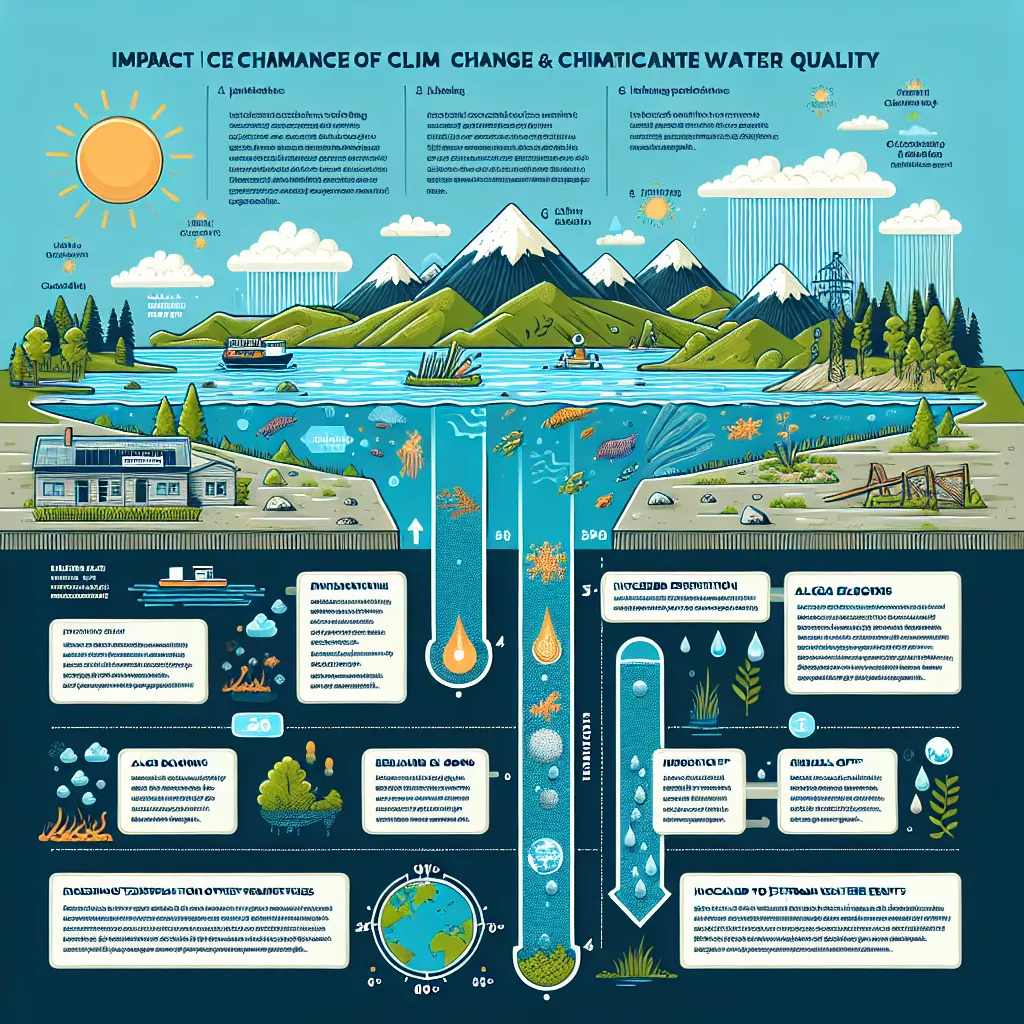The IELTS Reading section is a crucial component of the test, assessing your ability to comprehend complex texts and extract relevant information. Today, we’ll focus on a topic that has been increasingly prevalent in recent years: “The impact of climate change on water quality.” This subject has appeared in various forms in past IELTS exams and, given its ongoing relevance, is likely to feature in future tests as well.
Climate change and its effects on water resources have been hot topics in academic and scientific circles, making them prime candidates for IELTS Reading passages. By practicing with this theme, you’ll not only improve your reading skills but also gain valuable knowledge about a pressing global issue.
Let’s dive into a practice passage and questions that mirror the style and difficulty of the actual IELTS Reading test.
 Climate change impact on water quality
Climate change impact on water quality
Practice Reading Passage
The Impact of Climate Change on Water Quality
Climate change is one of the most pressing issues of our time, affecting various aspects of the environment, including water resources. While much attention has been given to the quantity of water available, the quality of water is equally important and is significantly impacted by climate change. This text explores the multifaceted relationship between climate change and water quality, examining how rising temperatures, altered precipitation patterns, and extreme weather events contribute to the degradation of water resources worldwide.
One of the primary ways climate change affects water quality is through rising temperatures. As global temperatures increase, water bodies absorb more heat, leading to higher water temperatures. This warming has several consequences for water quality. Firstly, warmer water holds less dissolved oxygen, which is crucial for aquatic life. The reduced oxygen levels can lead to “dead zones” in water bodies, where fish and other organisms cannot survive. Additionally, warmer temperatures promote the growth of harmful algal blooms, which can produce toxins that are dangerous to both aquatic life and human health.
Altered precipitation patterns, another consequence of climate change, also play a significant role in water quality. In many regions, climate change is expected to increase the frequency and intensity of both droughts and heavy rainfall events. During droughts, reduced water flow in rivers and streams concentrates pollutants, making the water more toxic. Conversely, heavy rainfall events can lead to increased runoff from urban and agricultural areas, washing pollutants such as pesticides, fertilizers, and sediment into water bodies. This influx of nutrients can further exacerbate the problem of algal blooms and lead to eutrophication, a process where excessive nutrients in water promote plant growth, depleting oxygen levels as the plants decompose.
Extreme weather events, which are becoming more frequent due to climate change, pose another threat to water quality. Hurricanes, floods, and storm surges can damage water infrastructure, leading to the contamination of drinking water sources with sewage and other pollutants. In coastal areas, sea-level rise and storm surges can cause saltwater intrusion into freshwater aquifers, rendering them unsuitable for drinking or irrigation. These events not only pose immediate risks to public health but can also have long-lasting impacts on water quality and ecosystem health.
The impact of climate change on water quality is not limited to surface waters; it also affects groundwater resources. Changes in precipitation patterns and increased evaporation rates can alter groundwater recharge, potentially leading to the concentration of pollutants in aquifers. Moreover, as sea levels rise, saltwater intrusion into coastal aquifers becomes more prevalent, threatening freshwater supplies for millions of people living in coastal areas.
Addressing the impact of climate change on water quality requires a multifaceted approach. Mitigation strategies to reduce greenhouse gas emissions are crucial to slowing the pace of climate change and its effects on water resources. Adaptation measures, such as improving water treatment technologies, implementing better land-use practices to reduce runoff, and protecting and restoring natural ecosystems like wetlands that act as natural water filters, are also essential.
In conclusion, the relationship between climate change and water quality is complex and far-reaching. As global temperatures continue to rise and weather patterns become more erratic, the challenges to maintaining clean and safe water supplies will only increase. Understanding these impacts is crucial for developing effective strategies to protect our water resources and ensure their sustainability for future generations.
Questions
True/False/Not Given
For questions 1-5, decide if the statements are True, False, or Not Given based on the information in the passage.
- Climate change affects both the quantity and quality of water resources.
- Warmer water temperatures lead to increased levels of dissolved oxygen in water bodies.
- Altered precipitation patterns due to climate change can result in both droughts and heavy rainfall events.
- Extreme weather events caused by climate change only affect surface water quality.
- Saltwater intrusion into freshwater aquifers is a concern primarily for inland areas.
Multiple Choice
Choose the correct letter, A, B, C, or D for questions 6-10.
-
According to the passage, which of the following is NOT a consequence of rising water temperatures?
A) Reduced dissolved oxygen levels
B) Formation of “dead zones” in water bodies
C) Increased growth of harmful algal blooms
D) Improved conditions for aquatic life -
Heavy rainfall events can lead to all of the following EXCEPT:
A) Increased runoff from urban areas
B) Washing of pesticides into water bodies
C) Eutrophication in water systems
D) Reduced concentration of pollutants in water -
Which of the following best describes the impact of extreme weather events on water quality?
A) They only affect drinking water sources
B) They pose short-term risks with no long-lasting impacts
C) They can damage water infrastructure and lead to contamination
D) They exclusively affect coastal water resources -
How does climate change impact groundwater resources?
A) By increasing groundwater recharge rates
B) By altering precipitation patterns and evaporation rates
C) By improving the quality of water in aquifers
D) By reducing saltwater intrusion in coastal areas -
Which of the following is NOT mentioned as a strategy to address the impact of climate change on water quality?
A) Reducing greenhouse gas emissions
B) Improving water treatment technologies
C) Implementing better land-use practices
D) Increasing the use of chemical fertilizers
Matching Headings
Match the following headings to paragraphs 2-6 in the passage. Choose the correct heading from the list below.
List of Headings:
i. Strategies for Mitigating Water Quality Issues
ii. The Effect of Temperature Rise on Water Quality
iii. Extreme Weather Events and Water Contamination
iv. Climate Change and Groundwater Resources
v. Precipitation Changes and Their Impact on Water Quality
vi. The Global Challenge of Climate Change
vii. Saltwater Intrusion in Coastal Areas
- Paragraph 2: __
- Paragraph 3: __
- Paragraph 4: __
- Paragraph 5: __
- Paragraph 6: __
Answer Key and Explanations
True/False/Not Given
-
True – The passage states, “While much attention has been given to the quantity of water available, the quality of water is equally important and is significantly impacted by climate change.”
-
False – The passage mentions, “Warmer water holds less dissolved oxygen, which is crucial for aquatic life.”
-
True – The text states, “In many regions, climate change is expected to increase the frequency and intensity of both droughts and heavy rainfall events.”
-
False – The passage discusses impacts on both surface water and groundwater, stating, “The impact of climate change on water quality is not limited to surface waters; it also affects groundwater resources.”
-
Not Given – The passage mentions saltwater intrusion in coastal areas but does not compare this to inland areas.
Multiple Choice
-
D – The passage indicates that rising water temperatures have negative impacts on aquatic life, not improved conditions.
-
D – Heavy rainfall events increase runoff and pollutant concentration, not reduce it.
-
C – The passage states that extreme weather events “can damage water infrastructure, leading to the contamination of drinking water sources.”
-
B – The text mentions that climate change affects groundwater by “Changes in precipitation patterns and increased evaporation rates.”
-
D – Increasing the use of chemical fertilizers is not mentioned as a strategy; in fact, fertilizers are mentioned as a pollutant.
Matching Headings
-
ii – This paragraph discusses how rising temperatures affect water quality.
-
v – This paragraph focuses on how changes in precipitation patterns impact water quality.
-
iii – This paragraph describes how extreme weather events affect water contamination.
-
iv – This paragraph specifically addresses climate change’s impact on groundwater resources.
-
i – This final paragraph discusses strategies for addressing the impact of climate change on water quality.
Common Mistakes to Avoid
-
Misinterpreting “Not Given” statements: Remember, “Not Given” means the information is neither confirmed nor denied in the text.
-
Overlooking key words: Pay attention to words like “only,” “all,” or “always” in the questions, as they can change the meaning significantly.
-
Falling for distractors: In multiple-choice questions, some options may be partially correct but not the best answer. Read all options carefully.
-
Relying on prior knowledge: Base your answers solely on the information provided in the passage, not on your own knowledge of the topic.
-
Rushing through the passage: Take time to understand the main ideas and structure of the text before answering questions.
Key Vocabulary
-
Eutrophication (noun) /ˌjuːtrəfɪˈkeɪʃən/: The process by which a body of water becomes enriched in dissolved nutrients, stimulating the growth of aquatic plant life.
-
Aquifer (noun) /ˈækwɪfər/: An underground layer of water-bearing permeable rock or unconsolidated materials.
-
Mitigation (noun) /ˌmɪtɪˈɡeɪʃən/: The action of reducing the severity, seriousness, or painfulness of something.
-
Algal bloom (noun) /ˈælɡəl bluːm/: A rapid increase or accumulation in the population of algae in freshwater or marine water systems.
-
Intrusion (noun) /ɪnˈtruːʒən/: The action of intruding or the state of being intruded upon.
Grammar Focus
Pay attention to the use of conditional sentences in the passage, particularly the zero and first conditionals:
-
Zero conditional: Used for general truths or scientific facts.
Example: “As global temperatures increase, water bodies absorb more heat.” -
First conditional: Used for likely or possible future scenarios.
Example: “If climate change continues at the current rate, water quality will deteriorate further.”
Practice forming these types of sentences to improve your understanding and use of conditional structures in English.
Tips for Success
-
Practice active reading: Engage with the text by underlining key points and making mental summaries as you read.
-
Improve your time management: Allocate your time wisely between reading the passage and answering questions.
-
Expand your vocabulary: Regularly learn new words related to environmental topics, as these are common in IELTS Reading passages.
-
Practice skimming and scanning: These techniques will help you quickly locate specific information in the text.
-
Read widely on various topics: This will improve your general knowledge and reading speed, both crucial for IELTS Reading success.
By practicing with passages like this and implementing these strategies, you’ll be well-prepared for the IELTS Reading test. Remember, consistent practice is key to improving your skills and achieving a high score.
For more practice on related topics, check out our articles on the impact of climate change on agricultural production and the impact of climate change on water supply.


